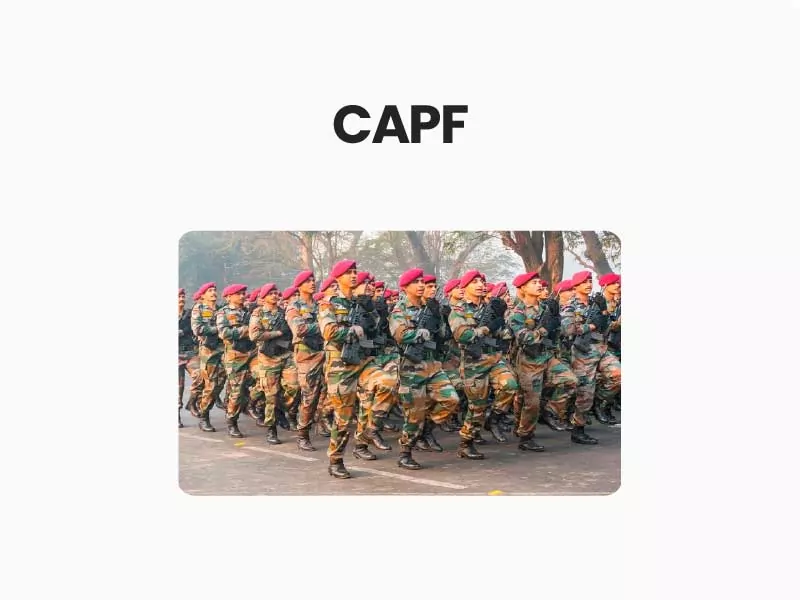
Central Armed Police Forces (CAPF)
The Central Armed Police Forces (CAPF) refers to seven security forces in India under the authority of the Ministry of Home Affairs.
- Assam Rifles (AR)
- Border Security Force (BSF)
- Central Industrial Security Force (CISF)
- Central Reserve Police Force (CRPF)
- Indo Tibetan Border Police (ITBP)
- National Security Guard (NSG)
- Sashastra Seema Bal (SSB)
Assam Rifles(AR):
- The Assam Rifles came into being in 1835, as a militia called the ‘Cachar Levy’, to primarily protect British Tea estates and their settlements against tribal raids.
- This Force significantly contributed in opening the region to administration and commerce and over time they came to be known as the “right arm of the civil and left arm of the military”.
- The Post-Independence role of the Assam Rifles continued to evolve ranging from conventional combat role during Sino-India War 1962, operating in foreign land as part of the Indian Peace Keeping Force (IPKF) to Sri Lanka in 1987 (Op Pawan) to peacekeeping role in the North-Eastern areas of India.
Border security force(BSF):
- The BSF, in its 54th years of existence, has emerged as an elite force of the country having excelled with distinction in the 1971 & Kargil war with Pakistan.
- BSF mission is “Any task, any time, anywhere”. The Officers and men have given blood and sweat to uphold its motto “Jeevan Paryant Kartavya”.
- BSF is “INDIA’S FIRST LINE OF DEFENCE”.
- BSF has been defending Sir Creek in the Arabian Sea and Sundarban delta in the Bay of Bengal with its state of art fleet of Water Crafts.
- BSF has an instrumental role in helping state administration in maintaining Law and Order and conduct of peaceful election..
Read Also Iron Dome aerial defence system
Central Industrial Security Force (CISF):
The CISF came into existence in 1969 with a modest beginning, having three battalions, to provide integrated security cover to the Public Sector Undertakings (PSUs) which, in those years, occupied the “commanding heights” of the economy.
- Central Reserve Police Force (CRPF):
It has become a premier multi-skilled security agency of the country, mandated to provide security to major critical infrastructure installations of the country in diverse areas. - CISF is currently providing security cover to nuclear installations, space establishments, airports, seaports, power plants, sensitive Government buildings and ever heritage monuments.
- Tthe CISF has provided Consultancy Services to more than 138 different organizations, including those in the private sector.
- After the Mumbai terrorist attack on November 2008, the mandate of the force has been broadened to provide direct security cover to private sector also.
- The CISF Act has been amended, heralding a new chapter in the glorious history of the Force.
- Among the important responsibilities recently entrusted to the CISF are the Delhi Metro Rail Corporation, VIP Security, Disaster Management and establishment of a Formed Police Unit (FPU) of the UN at Haiti.
- The Central Reserve Police Force came into existence as Crown Representative’s Police on 27th July 1939. It became the Central Reserve Police Force on enactment of the CRPF Act on 28th December 1949.
- The mission of the Central Reserve Police Force is to enable the government to maintain Rule of Law, Public Order and Internal Security effectively and efficiently, to Preserve National Integrity and Promote Social Harmony and Development by upholding the supremacy of the Constitution.
Broad duties being performed by the CRPF are:
-
- Crowd control
- Riot control
- Counter Militancy / Insurgency operations.
- Dealing with Left Wing Extremism
- Overall coordination of large scale security arrangement especially with regard to elections in disturbed areas.
- Fighting enemy in the event of War.
- Participating in UN peacekeeping Mission as per Govt. policy.
- Rescue and Relief operations at the time of Natural Calamities and disasters
Indo Tibetan Border Police (ITBP)
-
- ITBPF was raised on 24 Oct,1962.
- Presently, ITBP is deployed on border guarding duties from Karakoram Pass in Ladakh to Jachep La in Arunachal Pradesh covering 3488 km of Indo-China Border and manning Border Outposts on altitudes ranging from 9000’ to 18700’ in the Western, Middle and Eastern sectors of the Indo-China Border.
- ITBPF is a specialized mountain force and most of the officers and men are professionally trained mountaineers and skiers.
- Being the first responder for natural disaster, ITBPF has been carrying out numerous rescue and relief operations across the country.
- ITBPF was raised on 24 Oct,1962.
National Security Guard (NSG):
- The National Security Guard (NSG) is a counter terrorism unit. It was raised in 1984, following Operation Blue Star and the assassination of Indira Gandhi, “for combating terrorist activities with a view to protect states against internal disturbances.
- NSG formally came into being in 1986 by an act of parliament.
- The basic philosophy of NSG is swift and speedy strike and immediate withdrawal from the theatre of action.
- National Security Guard has been given the specific role to handle all facets of terrorism in any part of the country as a Federal Contingency Force.
- It is a task-oriented Force and has two complementary elements in the form of the Special Action Group (SAG) comprising Army personnel and the Special Ranger Groups (SRG), comprising personnel drawn from the Central Armed Police Forces/State Police Forces.
Read Also Rafale Aircraft
Sashastra Seema Bal (SSB):
- The Special Service Bureau (now Sashastra Seema Bal) was thus conceived in November 1962 and eventually created in March 1963 with the sole objective of achieving ‘Total security preparedness’ in the remote border areas for performing a ‘stay-behind’ role in the event of a war.
- SSB was started in North Assam, North Bengal, hill districts of Uttar Pradesh (now Uttarakhand), Himachal Pradesh, part of Punjab and Ladakh area of J&K.
- Later, the jurisdiction of SSB was extended to Manipur, Tripura and Jammu (1965), Meghalaya (1975), Sikkim (1976), Rajasthan (1985), South Bengal, Nagaland and Mizoram (1989). Its area of coverage included 15 states.
Enroll today with the best civils service academy and take your first step towards your Civils journey.
Feel free to reach out to us for any inquiries, collaborations, or support. We’re here to help.

